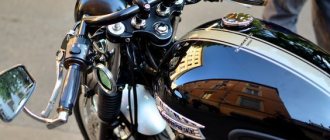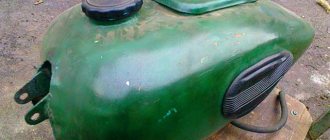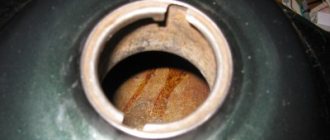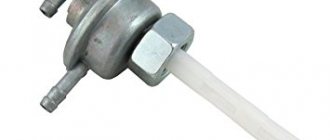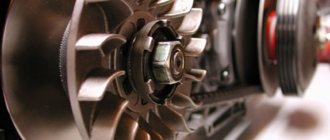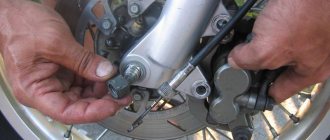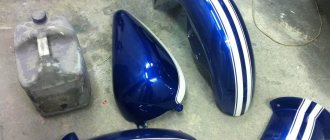28.10.2016
Rust in the tank - this problem faces owners of mainly old motorcycles. Sooner or later it appears, especially if the equipment is used incorrectly. Yes, and in gasoline now you can find water and other troubles that affect the condition of the metal. So what should we do? We need to clean it! Of course, the filtration system will not allow any more or less large pieces of rust into the carburetors/injector, but sooner or later it will come out sideways!……So let’s look at options for cleaning the tank. I won’t say anything new, but I hope it will be useful to someone.
How to remove water from a fuel tank?
To remove water from a gas tank, there are two simple methods: buy a special auto chemical product (moisture-displacing additive for gasoline) or pour alcohol into the tank. I use the second method, because it is the most effective, which is confirmed by personal experience and is financially beneficial.
Interesting materials:
How to install Google on your computer's home screen? How to set a picture on the Xiaomi lock screen? How to install a keyboard on a computer screen? How to set the desired screen resolution? How to set the taskbar at the bottom of the screen? How to install a plastic screen under a bathtub instructions? How to set weather on iPhone lock screen? How to set weather on lock screen? How to install the Yandex search bar on the home screen? How to set different wallpapers on each Android home screen?
Folk remedy
Some “Kulibins” take Coca-Cola or something like that (there’s plenty of nonsense out there), heat it to 35-40 degrees and leave it for a couple of hours. Why this water? The fact is that if you look at the chemical composition, cola also contains orthophosphoric acid, but it is slightly less than in the rust converter. But, as they say, they can eat away everything, including rust. Another interesting fact: all this machmala, along with rust, can be used to clean chrome or tiles with a toilet bowl well.
Preventing gas tank contamination
Cleaning the tank from water, dirt and rust with your own hands is quite simple. However, not every car enthusiast wants to do this. You can, of course, turn to professionals, but it costs money. It is much easier to prevent contamination of the tank and corrosion of its walls.
Epoxy against rust
Epoxy resins are used for anti-corrosion treatment of the inner surface of the gas tank. This coating is insoluble in water and gasoline, making it excellent for rust protection. To evenly apply the resin to all the walls of the tank, it must be poured through the neck, and then rotate the tank for a long time. When the epoxy has spread over all the walls of the tank, you can begin drying.
Anti-corrosion additives
Auto chemical stores sell anti-corrosion fuel additives. Among them there are very effective ones, but there are often cases when additives do not properly protect the gas tank from rust. Before choosing one of them, we recommend reading reviews on the Internet.
Smart car operation
The most reliable way to prevent contamination and corrosion of a gas tank is proper operation of the vehicle. A set of simple rules that, if followed, will save you from having to clean the gas tank:
- Monitor the quality of the fuel. Refuel only at approved gas stations.
- Monitor the amount of fuel. Try to keep the tank full. Be sure to fill it completely before parking for a long time. This will avoid the accumulation of water in the tank and its condensation on the walls.
- Try not to refuel in high humidity or foggy weather. If you still need to refuel, fill the tank full.
- With the onset of cold weather, add desiccant or alcohol to the tank in small quantities.
If a car's engine is its fiery heart, then the gas tank is its stomach, so it is very important for the health of the car to monitor its condition. Keep your tank clean and fill it with only quality gasoline, and your car will reward you with a smooth ride and long service life.
Water pressure
If you carry out the event frequently, you don’t need to use detergents and acids. It is enough to take a Karcher and rinse the inside of the gas tank with strong water pressure.
This method will save fuel filters from quickly depleting.
How to clean the gas tank:
- Disconnect the tank. Before doing anything, you must disconnect it from your motorcycle or other equipment. Without disconnecting the tank, you will not be able to access it or clean it safely. Unfold the tank and remove the screws or bolts that secure it. For lawn mowers and similar items, the fuel line and spark plugs must be removed.
- Close the fuel line. After disconnecting the fuel line, you need to block the access to gasoline. Dirt or other objects can get into the fuel line and cause problems. Take some kind of smooth clamp and attach it to the line near the carburetor.
- Empty the tank. Pour the remaining fuel into a gasoline-safe container. If you can't get everything out, use a suction hose or similar device to remove the fuel from the tank. Let the tank dry completely. Without draining the remaining fuel you will not be able to clean properly.
- Inspect the tank. Take the time to examine the tank, looking for any problems that could compromise its integrity. Defects, rust, or other problems may pose a potential safety hazard or may jeopardize the proper operation of the engine.
- Turn on the Karcher and spray high pressure water into the tank. It is necessary to treat all surfaces of the gas tank.
At the end of the procedure, it is necessary to dry the container and replace it.
If you are performing the procedure for the first time, take a photo of the disassembly process to make it easier to assemble later.
Cleaning a motorcycle tank from internal rust
In general, what can I tell you, friends. If you wash your motorcycle tank to remove rust, don’t repeat my mistakes. :))))) the tank is 25 years old, and apparently it stood empty and rusted for a long time.
So, I filled the tank with this hellish swill as hot as possible from the tap. Of course, first I dissolved all the powder in 2 liters of water (it will be a pain to dissolve in a tank). I left the full hot tank overnight. After 6 hours it had not yet cooled down, but it stood for about 14 hours. In the morning I successfully drained it. Typically, he poured in clear water and poured out yellow-brown water. I washed it with 10 liters of water, shook out the remaining peeling paint - and voila! There is no rust in the tank! only gray metal and remnants of paint. And before that, rust was everywhere. Glory to citric acid!
So! The correct procedure for cleaning a motorcycle tank is:
1. Drain the gasoline 2. Rinse with water, remove all dirt that has already peeled off and is floating, rinse again with water. 3. Pour a 3% hot (!) solution of citric acid overnight (or until it cools down). The best reaction is in a hot solution. Therefore, you can wrap the tank with a blanket or quilted pad so that it does not cool down so quickly. 4. Drain the acid, rinse the tank with water, possibly with the addition of soda. 5. wash with phosphoric acid or rust converter. Converter according to instructions. The acid creates a film on the surface of the iron that prevents oxidation of the metal (rusting). 6. rinse with water, dry and that’s it. You can use it.
On the forums it is generally recommended that after all these procedures, fill the inside of the tank with epoxy. Think. but even without this, the result exceeded expectations. Thanks to chemists and citric acid!
Phosphoric acid converter
Phosphoric acid is a potent chemical; it is recommended to use it outdoors, away from fire and heating appliances.
This converter is used with rubber gloves and safety glasses.
It is not recommended to use orthophosphoric acid in its pure form. If you do not comply with the proportions, you can cause irreparable damage to the fuel tank.
Cleaning the fuel tank yourself - step-by-step instructions for using the converter:
- First you will need to dismantle the tank. Follow this algorithm: remove the terminals from the battery, drain the remaining fuel from your gas tank, disconnect the fuel level sensor and disconnect the ventilation and fuel hoses. All that remains is to unscrew the screws and carefully remove the container. Place the gas tank on a level surface.
- First, wash the inside of the container with hot water. This will help remove large chunks of rust and dirt. Hot water is poured into the gas tank, closed and shaken vigorously. The dirty liquid is poured out and proceed to the next step.
- 500 ml of converter with orthophosphoric acid is poured into the container. The tank is closed and slowly rotated so that the liquid is distributed along the walls.
- Cleaning the gas tank will take 1-2 hours. After 1 hour, you can drain the converter and perform a final flush. If there is a lot of rust, the procedure is repeated.
- The final rinse involves filling the reservoir with water. 100 grams of baking soda are poured there per 10 liters of liquid.
- All that remains is to dry the tank. There should be no liquid left in the gas tank. Drying takes 3–4 hours.
You will have to devote almost the entire day to the procedure to thoroughly clean the gas tanks from rust.
We suggest you read How to get rid of flies in the house quickly at home, why is it necessary to fight them?
After the converter has washed away all contaminants and the tank has been dried, you can install it in the car.
This method of washing will not leave any trace of corrosion. She won't appear for a long time.
Sources of pollution and combating them
The gas tank is the starting point in the movement of fuel through the vehicle's systems. However, in its depths, in addition to gasoline, you can sometimes find something that shouldn’t be there. Contamination of the tank can lead to impure fuel, and sometimes no fuel at all, entering the engine, and this can lead to serious damage. Signs of a dirty gas tank are:
- problems starting the engine after parking,
- uneven engine operation,
- frequently clogged injectors and fuel filters.
One of the main threats to a car’s fuel system in general and the gas tank in particular is water. It gets into the gas tank with diluted gasoline at dubious gas stations, but even if you fill your car with exclusively high-quality fuel, you are not insured against water in the tank.
How to clean rust from a gas tank?
Here, as you understand, we will talk about cleaning the fuel tank from rust from the inside. After all, the whole difficulty lies in the fact that we only have access to the inner surface of the tank through the neck. So, let's start with the reasons why corrosion appears inside the tank. Hello to those who like to drive on an empty tank! It is one thing when in this case the vehicle is constantly in motion, and another when it is idle in a garage or in a parking lot. Most of the tank is not in contact with the fuel, and due to temperature changes, water vapor condenses on its walls. Therefore, if you have to park the vehicle in the garage for a long time, fill the fuel tank to capacity.
The car fuel filter is clogged with rust.
A good friend of mine who deals in used motorcycles often comes across rusty tanks. Before motorcycles are shipped from Japan, all gasoline must be drained at the marine terminal. A rather long period may pass after sending. And it also happens that even before the terminal it stood for a long time without fuel. The bottom line is that we have a rusty tank.
Further actions depend on how deep the corrosion has eaten into the tank wall. If it is significantly covered with rust from the inside, then you can use a simple and reliable method. We take the nuts, pour them inside and fill them with gasoline or kerosene. We close the tank. Shake thoroughly like a tambourine and pour out the resulting mixture. Fill in another portion of gasoline for final rinsing. Next, in order to remove small rust residues, you can use already proven orthophosphoric acid or special rust converters.
But as a rule, they penetrate so deeply that this can then affect the further restoration of the tank. No matter how hard you try to wash it, it will show itself on the outside during paint and varnish work. You can think for a long time why the paint swells. Well, this is if we are talking about motorcycle fuel tanks, which bikers paint with special trepidation. With automobiles, the situation is simpler, since the maximum that is required of them outside is to cover them with soil and bitumen mastic. In general, you need to act depending on the degree of corrosion on the tank walls.
Many people have heard that a drink such as Coca-Cola or Pepsi is used as a rust remover. The thing is that it contains the same orthophosphoric acid. Judging by the videos on Youtube, there are many examples of cleaning rust traces with this drink. Personally, I haven’t tried it, but I’ll have to try it.
Yes, and don’t forget about safety precautions when working with rust converters, because virtually all of them contain acids that can cause a reaction on exposed skin. Wear rubberized gloves.
An interesting method of cleaning tanks by electrolysis. To do this we need a 12 V battery, a couple of wires, soda and water. The photo below shows a 15 liter tank. Prepare a solution in the proportion of 100 grams of soda per 10 liters of water. Fill in the solution. We immerse the wire from the positive terminal (anode) inside the tank so that it does not touch the walls. We connect the wire from the negative terminal to the tank body. Leave it for a couple of days. Voila! The tank is clean.
